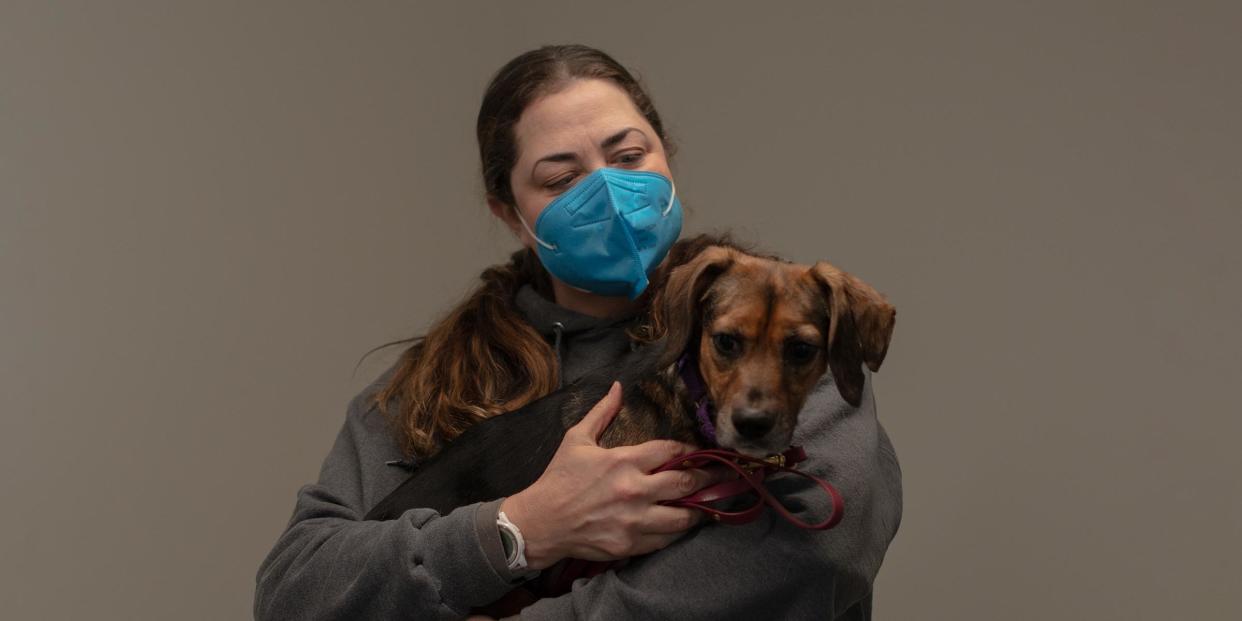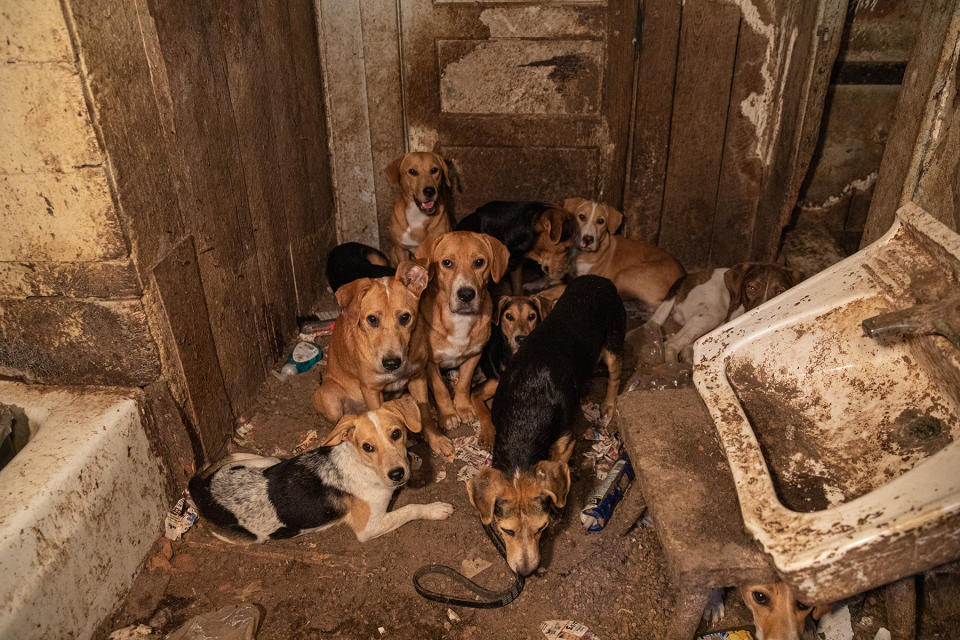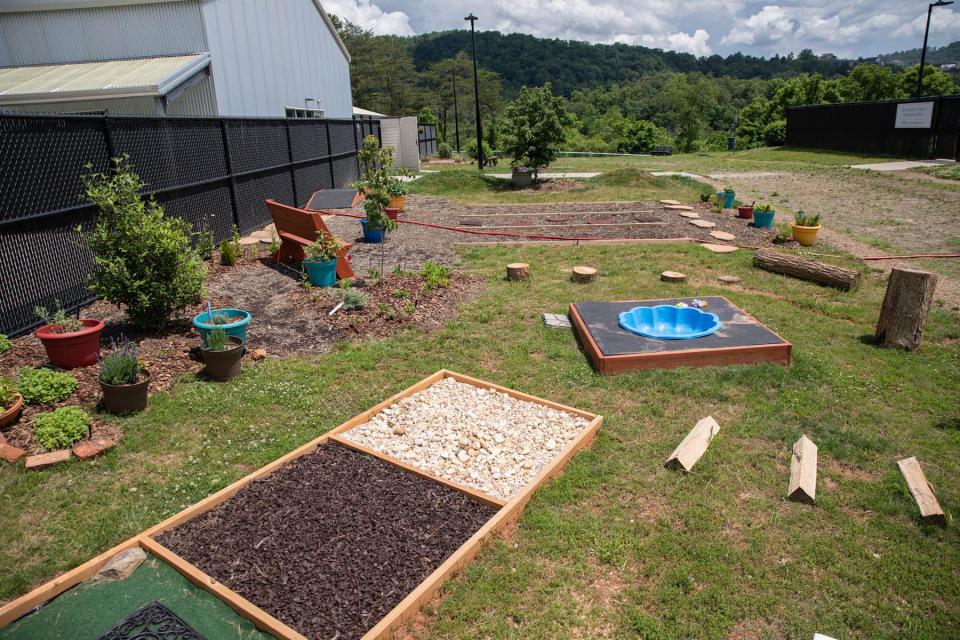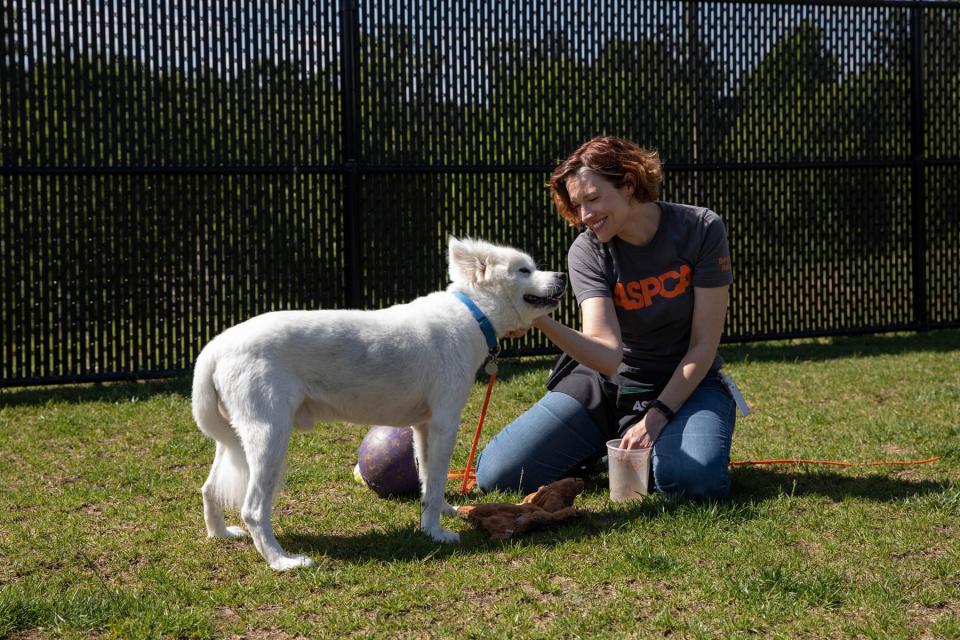1,000 Dogs Are Put Down Every Day. These Trainers Are Trying to Save Them

The day her dog went missing, Shanna Phillips lost her mind. Her first week at a bakery in Fairview, North Carolina, she dashed out, mid-shift, to scour the woods. In the three months since she’d found and adopted Sassy, that dog had salved her soul and heart after her mother died young of cancer. Effectively, Sassy had done what counseling alone couldn’t: roll back Phillips’ fear of dropping dead at 22. Now Sassy, who’d come through hell herself, was lost in a town she barely knew. Sobbing, Phillips phoned her friends and family, mustering a search party of eight. They combed the streets and side yards, postered Quick Marts and stop signs, and mounted large-font bulletins on Facebook for a small beagle mix with soulful eyes.
For two days, Phillips neither slept nor ate. At one point or another, there were 20 people chasing down porch-cam sightings of Sassy. Meanwhile, Phillips’ boyfriend cut short a trip to beachfront Mississippi. “I was worried for Sass, but more so for Shanna — she loves that little dog like…” says Bryce Myers, a hydraulics engineer in his mid-twenties. “When you know what they’ve been through, you get why they’re so bonded.”
More from Rolling Stone
Watch Phoebe Bridgers, Clairo Perform Together Live in Milan
Former Teacher, Parents of a Toddler, Grandfather Among Victims of Highland Park Shooting
Sassy ran away on a Thursday morning. Friday night, Phillips was at the end of her tether when she heard a scrape at the door. She ran down to open it. There stood Sassy, giving a flick of her tail. “She walks in all chill, like, ‘How’s your day been?’” says Phillips. “I got down on the floor, sobbing — I could not stop hugging her.” Sassy had gone all the way up a nearby mountain and somehow come back home without a scratch. It was one more wonder from a magic dog whose stock in trade seems to be cheating death.
Sassy’s walk-off happened in the fall of 2020, when she was a year-and-a-half old. I met her in the fall of 2021, on the porch of the snug Craftsman that Phillips and Myers rent outside of Asheville. It was a brilliant afternoon in the Blue Ridge Foothills, and Sassy had the zoomies something fierce. Whoossshhh! went the small, brown blur going by, carving the corners of their quarter-acre lawn. Skirrshhh! went the leaf pile as she spin-cycled through the turns. She stopped for a belly rub and a stick of pepperoni, then charged off to scare the bejesus out of a rabbit. Here was a dog in Disneyland, so struck by joy you could plausibly call her stoned.
It didn’t start this way when Phillips adopted Sassy in the summer of 2020. The dog barfed in her car and pooped in her apartment, all within their first hours together. For weeks, she wouldn’t suffer her owner’s affections, but Phillips was prepared to wait her out. She knew enough of Sassy’s history to let time, space, and dog treats do their magic. “They told me she came from a crazy hoarder who had twenty-something dogs in a trailer,” Phillips says. Actually, the count was 29 — and “crazy” doesn’t begin to describe the owner.
A middle-aged woman in Yellville, Arkansas, with no ties to friends or relations, she was living with her dogs in a storage unit upholstered in piss and shit. The couch she slept on was soaked in urine; the floor was carpeted in turds. Exposure to the toxic particulates in pet waste had sickened, scarred, or killed the unit’s canine occupants. Long-dead dogs lay chockablock with puppies struggling to breathe.
Severe mange and bug bites, feet bleached white by urine. Kyle Held, the ASPCA’s investigator in the case, has walked hundreds of such scenes in his day. “You don’t get too attached to footwear in this job,” says Held, a burly giant who delivers lines so dry, you’re never quite sure he’s joking.
This case presented him a special challenge: The door of the unit was broken. Held somehow threaded his six-feet-two frame through a rusty window. Using a control pole, he snared the panicked dogs and handed them up to staffers holding crates. Happily, most of the rescues were on the smaller side: beagle mixes under 30 pounds. It got a little gnarlier with the German shepherds, but Held’s done this work for 28 years, the past 12 leading a response team for the ASPCA from his home state of Missouri. “You want a crash course in animal cruelty, Missouri’s your state,” he says. “Tigers, horses, reptiles, dog fights. It’s also the world capital of puppy mills.”

ASPCA
Often after a seizure by the ASPCA — or “the A,” as staffers call it — there are criminal charges pending against the owner and a scrum over custody of the dogs. In this case, however, the hoarder dodged jail time by agreeing to release her pets. (She also signed a binding — or else — waiver that she’d never own dogs again.) The ASPCA had already pivoted to phase two of rescue, installing a temp shelter in a warehouse. Domiciled for weeks there, the dogs were seen by vets, who performed surgery on the most badly injured patients. The ASPCA also flew behaviorists in to assess the mental health of the dogs. They were graded on several axes: fearfulness of people; aggression and hyperarousal; ease of handling and feeding. A few of them scored in the middle range of trauma, meaning the ASPCA could treat and train them at the temporary shelter and prepare them for local adoptions.
But the bulk were so stricken by the sight of human beings that they soiled themselves and hid in abject terror. Sassy was one of those petrified dogs. Besides her sundry ailments — a coat severely scarred by mange; “hookworms, whipworms, a grade-three heart murmur, pain from her skin condition, an ear infection, a low body-condition score (3/9), and grade-two, -three dental disease,” per her intake form — her psyche was so scrambled by neglect and cruelty that she lived in a state of dread. Staffers had to turn their backs when they fed her. She couldn’t bear being looked at, let alone touched. Failing an intervention, she’d join the 400,000 dogs put down each year for the crime of being homeless or having behavioral issues. The cruelty of their fate is almost cosmic. Saved from horrific circumstance by cops or rescue teams, they are euthanized shortly after to end their suffering.
But Sassy and her mates from the storage unit had a miracle in store. In the spring of 2020, they were trucked hundreds of miles to the world’s first clinic for severely traumatized dogs: the ASPCA’s Behavioral Rehabilitation Center (BRC) in Weaverville, North Carolina. There, in three transformative months, they’d get a crash course of nurture and training from data-driven teams of pet behaviorists. In tiny blocks of treatment — 15 minutes a day — they’d haltingly push through their fear of people, discover the joy of being creatures at play, and emerge from lives of unspeakable pain to become someone’s wonder dog.
It is astonishing to think how indifferent we are in the face of animal suffering. Pigs penned in chutes the size of their bodies on America’s factory farms. Egg-laying hens packed 12 to a cage, their crests caked in shit from the birds above them. Breed dogs trapped in puppy-mill crates, never touching grass or feeling sun on their backs from birth to brutal death. In America, we don’t just stomach cruelty, we license and sell it in aisle three.
There’s another kind of cruelty we turn our backs on: More than a thousand dogs in shelters are put down daily, and virtually all those dogs could have been saved. Roughly one percent of the euthanized pups were sick or posed a threat to someone’s safety. The rest were destroyed because their shelter ran out of space — or because their behaviors put off adopters. Distressed dogs yelping and cringing in fear; overanxious pups that paced their crates when approached: It was all too easy to pass them up. As for dogs like Sassy, piebald with mange and gnawing at the bug bites on her shins, there was no chance — none — to leave a shelter alive. Until the BRC came along.

ASPCA
First, though, someone had to find those dogs and take them from the people who did them harm. There are laws on the books banning blatant abuses, but they’re rarely enforced by the cops. Instead, it falls to the animal-welfare groups to root out crimes against dogs. “In February 2010, we launched our Field Investigations and Response teams to deal with abuse cases,” says Matt Bershadker, the ASPCA’s president and CEO, who was hired in 2001 and climbed the ranks to become its leader in 2013. (The Humane Society of the United States formed its own unit in 2009. Its yearslong probes of America’s puppy mills were featured in this magazine in 2017.)
In the years since the ASPCA began tracking abusers, it’s either assisted in or led massive takedowns: the arrests of 10 gangsters in 2013 and the seizure of 367 dogs, the second-biggest dog-fighting bust on record; the rescue of the so-called Missouri 500 dogs — the biggest dog-fighting bust on record — and the arrests of 26 people; the removal, care, and placement of more than 500 dogs from a fetid puppy mill in Iowa in 2021.
But it’s one thing to free malnourished dogs who’ve been chained to trees, scarred and bleeding. It’s another entirely to soothe their souls and teach them to trust the species that abused them. “Not only have they never been held and loved, they’ve never really been dogs,” says Kristen Collins, vice president of ASPCA Rehabilitation Services. “They’ve been widgets for breeders and things gamblers bet on.”

ASPCA
Collins is a certified animal behaviorist who joined the ASPCA in 2007. Several years later, she conceived the BRC with her fellow behaviorist at the ASPCA, Pamela Reid. The unit was born of horror and grief, after a particularly gruesome find in Tennessee. One steam-bath afternoon in the summer of 2010, Collins and Reid were summoned by the authorities to a grim tableau. An old man was living at the end of a dirt road in a decrepit trailer packed with dogs. “We counted 85 in terrible shape, both physically and behaviorally,” recalls Collins. They were skinny to the point of emaciated — neither food nor water was set out — and there was trash piled everywhere she looked. In those days, the ASPCA had no triage unit, so the team couldn’t house or treat the dogs. After brief exams, they were sent to local shelters, where most, if not all, were put down. “It broke our hearts to see so much suffering,” says Collins. “For hours, we drove in dead silence.” She resolved then and there that they had to do more: “We need to be able to heal them behaviorally so they can go on and live happy lives.”
Reid and Collins assembled a roving team to respond to such disasters. “Those early days, we were trying to MacGuyver with a hair clip and a stick of gum,” she says. They’d rent an empty warehouse, cull vet techs from local shelters, and do the dirty work of triage care. Giving lime baths to dogs with tick bites and ringworm, making boxes and platforms from plywood scraps so mama dogs could escape their week-old pups: “It was all improv, but we were building a framework for the holistic model to come.”
A year later, Collins got a call from a district attorney in Kentucky: 120 dogs had come out of a puppy mill in Morehead in deplorable condition. By then, the ASPCA had its response team ready. Collins worked for weeks at its temp site nearby, throwing everything she’d learned in 10 years of training at those dogs. “We tried really simple things, like drive-by treating, where you toss a piece of cheese into a dog’s kennel as you’re walking past it,” says Collins, who holds a master’s in animal behavior from the University of Illinois. “They’re so undersocialized they can’t bear you coming in. But over time, they learn to connect you with something yummy, and start coming closer to the door.”
Another ploy that worked was bringing in “helper” dogs: pairing less-fearful pups with panicked ones to play in short sessions. “I can’t overstate the importance of helper dogs,” says Collins. “Not only did they help relax the scared ones, they modeled all the stuff that dogs do. Sniffing, chasing, tugging, playing: All that was new to those dogs.”
Over weeks of treatments, Collins saw “marked improvement” in a large majority of cases. Even the very fearful started sniffing around their handlers, letting themselves be touched and fed by hand. Here was early evidence, via small-batch data, that badly abused dogs could bounce back. Collins and Reid made their pitch to the ASPCA’s chief; Bershadker pitched his board of directors. He came back with the money for a pilot program: a temporary clinic for the “worst of the worst” cases.
Collins and Reid rented kennel space from a shelter in Madison, New Jersey. Before opening their doors, they did “brain-dump sessions,” scribbling every technique they could possibly think of on a whiteboard. Out of those sessions came the 30 or 40 protocols that form the core of care at BRC. “We took the biggest blocks dogs have to getting adopted and broke them down to small parts,” says Collins. She cites leashing as an example. It can evoke terror in dogs who’ve never been handled before: “You’ll see them freak out, go into gator rolls. They’ll flop to the floor and roll over and over, trying to get that thing off their neck.”
So she and her behavior specialists took it beat by beat. In those first days, all they did was show the dog a leash while feeding it treats and rations. Next, they let the dog sniff the drag line, a thin cord that clips to collars. Then, they attached it and played follow me, in which the behavior specialist dropped cheese cubes and stepped off quickly, inviting the dog to chase. “She feels the weight of the line and gets used to it,” says Collins. “Once that happens, we grab it and take a few steps, dropping cheese behind us.” Repeated over and over, the dog gets used to the pressure around its neck. Soon, it’s ready for a real leash — and the next challenge, walking outdoors.
When the Madison site opened in 2013, Collins hoped to save half those haunted dogs. Within months, she had to raise the bar: Almost 90 percent of the dogs in her care improved enough for adoption. Once too terrified to leave their kennel, dogs were coming out to play with other dogs and forming attachments to their handlers. They took to being leashed and walked on trails, went for short rides in staffers’ cars, and didn’t melt down in public parks when exposed to new dogs and people. “We knew dogs were resilient, but this was something else,” says Collins. “It was an ability to trust — and forgive.”

Jesse Barber for Rolling Stone
The clinic’s two-year lease was extended twice. Meanwhile, the ASPCA scoured East Coast states to build a permanent home for the BRC. They found their site in Weaverville, a 15-minute drive from Asheville. Encircled by Trumpland, Asheville’s as much a symbol as it is a city: the promise of an agnostic, tolerant South that never seems to come to pass. It’s a peach-fizz town of gastro pubs and gender-fluid teens rocking dusty Chucks and hair colors unseen in nature. Seemingly everyone’s got a skateboard or a graphic-arts side gig — and dogs are part of the mix. You can’t go a block here without stepping around someone’s rescue in a tie-dyed harness or Pride bandanna.
“Asheville greeted us with open arms,” says Bershadker. “It was a progressive community that loved pets and animals,” and had a census of sentient twentysomethings. The ASPCA bought a parcel in 2014 and erected a clinic like none other. It looms like a spaceship behind its cyclone fence: a sleek, low-slung compound in matte-white brick on 12 sloping acres and trails. Each of the 52 dogs in treatment has a kennel the size of a small dorm room: glass doors and walls, a futon to nap on, and saloon doors to their own fenced dog run.
The clinic is divided into A and B pods. Each pod has play spaces inside and out, treatment labs called Real-Life Rooms, and a high-gloss kitchen for food prep. The pods both share a gym — yes, a gym for pups, with tunnels and cones and an obstacle course — as well as a dog park with high, screened walls so the dogs aren’t fazed by passing cars. In the afternoon, play groups of six or seven dogs run themselves ragged out there. They chase cubes of cheese and hot-dog bits tossed by behavior specialists and the occasional guest. There are 35 full-time staffers on campus, dozens of volunteers pulling regular shifts, and a robust list of enrichment options available to the dogs. Their daily treatment, however, lasts exactly a quarter of an hour. “They’re so undersocialized that it’s all they can take,” says Collins. “Push them any longer and they’ll crash.”
By the time Sassy got to the BRC, her physical woes had responded well to treatment. There were scars on her nose and paws that she’d wear forever, but on a dog so pretty, they looked like freckles, not badges of gross neglect. Her psyche, however, was another story. She was scared “to the point of extreme” around staff and “looking for escape routes,” per her case file. “Especially our male staff,” says Darren Young, a behavior specialist who worked with Sassy, then handled her adoption to Shanna Phillips. “That made it somewhat challenging,” he says with a laugh.
Young, who’s 49, is an outlier on staff. He and his wife, Christine, owned an IT company and volunteered at New Jersey shelters. In 2013, they launched a project to house homeless pit bulls and connected with the ASPCA’s temp site in Madison. There, they got so invested in the work that they studied to become behavior specialists themselves. Hired by the ASPCA, they sold their house and firm and moved to North Carolina with the BRC. They’re older and better established than most of their colleagues, scruffy thirtysomethings who’ve kicked around a while before finding their lane in life. Their uniforms — gray T-shirts, blue cargo pants, and utility belts packed with treats — neatly convey the grunge aesthetic of animal-welfare work. There’s an urgency in their gait as they move about the unit: Dogs are distressed in every kennel.
With Sassy, that panic was weirdly mixed. She was, as they say here, “conflicted.” On the one hand, she was terrified of people. On the other, she was curious — and hungry. “Man, that little girl loved to eat; she was so food-motivated,” says Young. To work past her fear, he employed a technique that’s known as “treat and retreat.” Those first 10 days, he’d enter her kennel and soft-toss kibble from a distance. Then, bit by bit, he’d lob it closer and step off while she ate it. Eventually, she came near enough to snatch food from his hand. When she did that, he’d give her a sly scratch behind the ear, the first bit of handling she’d had. By the two-week mark, she was targeting his palm, touching it with her nose for kibble.
An affinity was forming — highly unusual in a dog so new to treatment. The next step for Young was to spread the love: transfer her affections to other people. Young and his team did rotations with Sassy so that she bonded with all five of them over time. Then they brought in novel people: volunteers who clean kennels and do the endless loads of laundry. “We’d have them just sit there and say nothing to the dog, maybe toss her cubes of cheese,” says Young. Eventually, Sassy came over to the stranger — first, to sniff them, then to bogart hot dogs from their hand.
“It was amazing to watch her open up,” says Young. “She still barked a lot — they named her Sassy for a reason! — but she came a long way in a short time.” That she did: Sassy almost set the record for swiftest graduation at BRC. The typical course of treatment here is 13 weeks; Sassy completed the program in just five. She got her framed diploma and a name card coded green, meaning she was ready for adoption. But life had another jolt in store for her. It was early April 2020 — the country was locked down tight by the first wave of Covid.
Young posted Sassy’s photo on Petfinder and Adoptapet.com, and reached out to several shelters in the region. When Phillips saw her picture, she was smitten: “There was something in Sassy’s face,” she says. “She looked like she was smiling. I knew it in my soul: That dog was mine.”
Phillips reached out to Young. She was anguished to hear that someone else had claimed her first. “Bullshit,” thought Phillips. She paid Sassy three calls in five days. That first time, she sat in one of the smaller play yards as Young led Sassy in. The little dog ran to the far end of the yard and sat with her back turned most of the visit. “She hates me,” Phillips thought — but returned to BRC. The next time, Young brought a helper dog along. Sassy softened enough to creep near Phillips and scarf the treats that she and her boyfriend lobbed. Things went well enough that the couple took her for a walk. The moment they rounded a corner, though, Sassy flopped to her belly. “She’d lost sight of me,” says Young, who’d strolled away on purpose. “I needed to see if she was ready to leave.” As it turned out, not quite yet.
Finally, on their third date, Sassy let Phillips hold her. She picked up the dog and bundled her in tight. They stood there swaying and nuzzling in the breeze. Lifting her head, Sassy anointed Shanna with the faintest flicker of a kiss.
In the nine years since the ASPCA funded its pilot site, the BRC has rehabbed more than 500 dogs and placed them in what staffers call “forever homes.” None of those pups were finished products when they finished treatment. “We get them far enough to thrive in someone’s house, but the rest is up to that family,” says Young. “The [dogs] are gonna be afraid still, and there’s gonna be behaviors. But if you give ’em the love and support they need, just watch what they become in a year.”
Which brings us to the countless adoptable dogs languishing at shelters around the country. We have come a far distance in “live releases” — the number of pups adopted — over the past two decades. In 2000, 90 percent of the dogs in “pounds” were euthanized within days of arrival. Last year, that figure was nine percent, an extraordinary, if incomplete, achievement. For 40 years, the leaders of the animal-welfare movement have waged a two-front war to save pets’ lives. The first was pushing for spay-neuter laws to shrink the number of homeless dogs. A single unhoused female could birth 600 pups, most of whom would lead wretched lives that ended with a pentobarbital shot. “Ten million pets were put down each year: That was the number we used to shock the public into action,” says Tom Colvin, the CEO of the Animal Rescue League of Iowa, who’s been a powerhouse in the field for 50 years. More than 30 states now mandate sterilization, easing — but not eliminating — the crush at shelters.

Jesse Barber for Rolling Stone
The second front was changing people’s hearts and minds about where they got their pets. “There was so much stigma attached to dog pounds, which used to be located by the sewage plants,” says Colvin. But the rescue movement enlightened the public on the virtues of shelter dogs. Adoptions have spiked since the early aughts, then soared out of sight the past two years. Twenty-three million dogs were adopted during the pandemic, a 600 percent increase over the norm.
Still, 3 million dogs remain in shelters, many in need of clinical care. The ASPCA can only treat about a hundred dogs a year at its North Carolina location. This fall, it will open a significantly larger unit for dogs with moderate trauma: the Cruelty Recovery Center in Columbus, Ohio. And by summer of next year, it will launch a third clinic: the Recovery and Rehabilitation Center in Pawling, New York, for hyperaroused dogs whose manic behaviors prevent them from being adopted. But no organization can do this job alone. What’s needed is a second wave of rescue pros: a national surge of partners and behavior specialists to prepare those unhoused dogs to go home.
To build that wave, the ASPCA put its wallet on the table. Beyond the $40 million to construct its three clinics, it funded an academy at the BRC to teach frontline workers from other shelters. Behind its clinic sits a handsome block of dorm rooms for visiting staff and executives.
“I’ve got a team there now for a core retreat; I’d go every month if they let me,” says Alison Reder, the vice president of operations at Wayside Waifs, a 200-dog shelter in Kansas City, Missouri. Inspired by what they learned, Wayside’s leaders built a replica of the BRC behind their busy shelter. “The difference in the dogs that go through our clinic — it’s night and day,” says Reder. “We had a pit bull named Angelo that no one wanted; he spent 200 days at our shelter. But three weeks at our clinic, he went home with a family. You’ve never seen a dog so happy, or relieved.”
Last May, the ASPCA got another of those calls: a house-of-horrors dwelling in Ohio. Out of a single trailer came 90 dogs, living — and dying — on counters and cabinets and holes they’d dug in the wall. One of those dogs was Cheddar, a small beagle mix who looks a bit like Sassy. Unlike Sassy, that dog was no puppy: He’d gone blind in both eyes from years of exposure to the contaminants in the house. To describe his other ailments would be piling on. All that’s germane was the state of his psyche when Cheddar arrived last summer.
“Oh, boy,” says Christine Young. “I don’t know if I’ve had a tougher case. That dog didn’t leave its kennel on its own for at least two months.”
Young, who’s married to Sassy’s behavior specialist Darren Young, was born to treat broken dogs. She’s soulful, soft-eyed, and speaks in spa tones, but you need more than heart for dogs like Cheddar — you need an eye for the slightest sign of progress, and the patience to wait as long it takes. Young would not hear the murmurs of other staffers or her own nagging fear about euthanasia. As long as Cheddar exhibited something to build on — an uptick in appetite; an interest in other dogs — she was resolved to keep pushing.
“With Cheddar, his blindness made it so much harder; dogs learn to trust through body language,” Young says. “He had no visual cues.” Finally, months along, Young had a breakthrough moment. She was feeding and petting a second dog when Cheddar cocked his head and came nearer. “He could kind of, sort of see that I was loving up that dog — and that made him competitive,” she says. He got close enough to Young to sniff her hand; she gave him a furtive scratch behind the ear. He liked that, so she gave him another scratch. For the first time, she saw his posture soften.
But it was autumn before she managed to get a leash on him and walk him to the smaller of the yards. Often, he’d whip his head at handlers: “He wanted nothing to do with any of us,” says Young. But that tiny tell she’d spotted — his envy of other dogs — proved to be her gateway to Cheddar. When Tibbets — another of the Ohio rescues — presented himself for cuddles, Cheddar would leap on Young’s lap and press against her hand.
The months ticked by; Cheddar’s progress was glacial. No one knew when — or if — he’d make the crucial leap. Eighty-six percent of the dogs at BRC come far enough in treatment to graduate. Simple math will tell you that the other 14 don’t; at some point, a decision is made to end a dog’s pain humanely. There are team meetings weekly in either pod, then meetings with pod leaders and the clinic’s directors. Each dog’s progress is discussed in those meetings, as well as their sticking points.
“Do we feel like their quality of life is improving and that they’re able to learn?” says Sarah Shively, the senior director of operations at BRC. “Can they do canine things like digging and marking, or do they spend the majority of time in a state of fear?” If, after months of treatments and approaches, a dog has stalled out and is still suffering around people, a consensus is reached to terminate treatment and end the dog’s life. (Some dogs, such as Cheddar, may be in the program for a longer duration if improvements are slow but steady.)
But Cheddar thrilled everyone when he finally turned a corner in December. He stopped skulking in his kennel when his behavior specialist approached. In play groups, he roughhoused with other dogs, though his idea of fun was to jump them, feet first, like a canine Jackie Chan. He graduated in February after 28 weeks, a very long stint at BRC. Because of his blindness, the ASPCA kept him in-house till someone in the area applied to adopt him.
Andy and Jessica Ferguson had lost a dog to cancer and were grieving her loss deeply when they saw Cheddar. “There was a pretty big hole in our house to fill; our other dog, Samson, was grieving, too,” says Andy, who, like his wife, is a high school teacher. “We seem to choose the dogs who choose us,” he says.
It’s been a fortnight since the Fergusons brought Cheddar home. The space left behind by their sweet hound Sarah has been filled with commotion — and squeak toys. The first day the couple left their dogs alone, they erected a pen for Cheddar in the hallway. When they walked in the door, the pen was knocked flat and the two dogs were sunning side by side. “Samson broke him out playing doggy linebacker,” says Andy. “Cheddar is Velcro’ed to Samson.”
Except, it seems, at night, when Cheddar hops up on the bed and nestles between Andy and his wife. He’s done that since his second day home. That first night, the couple took shifts on the recliner, catching a few hours’ sleep apiece with Cheddar curled up in their laps. They know little of his backstory and like it that way — their love is such that they cannot bear the details. The word they use most about that dog is “grateful.” He has dressed their wounds as they have his.
To support the ASPCA’s ongoing work to help animals like Sassy and Cheddar, please visit aspca.org/rehab
Best of Rolling Stone

